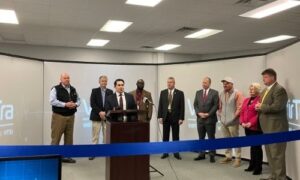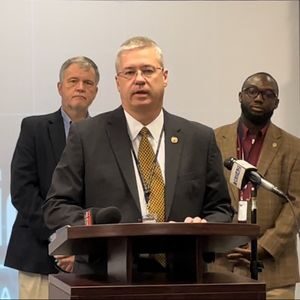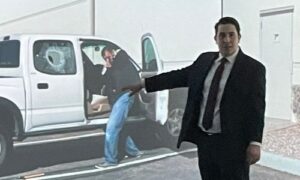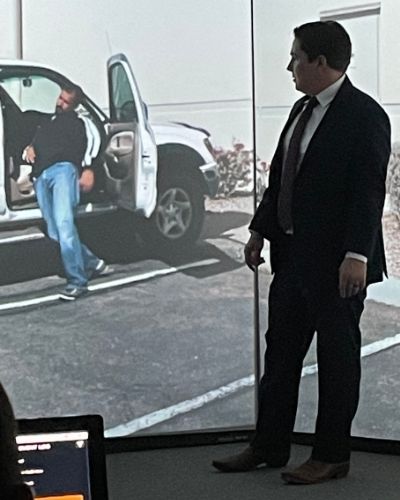 The JSU Center for Best Practices in Law Enforcement invited the media to attend a ribbon cutting for a state-of-the-art police training simulator on March 9. Regional law enforcement officials and members of the university administration were on hand to see the launch of the new Virtra 300 training system. The five-screen, 300-degree simulator is designed to immerse police officers in training situations that force them to make tough decisions in real-time, such as de-escalating tense interactions or engaging with an active shooter. The simulator will be available to any law enforcement agency in the state, free of charge. The equipment was funded by a grant from the Poarch Band of Creek Indians which allowed the lease.
The JSU Center for Best Practices in Law Enforcement invited the media to attend a ribbon cutting for a state-of-the-art police training simulator on March 9. Regional law enforcement officials and members of the university administration were on hand to see the launch of the new Virtra 300 training system. The five-screen, 300-degree simulator is designed to immerse police officers in training situations that force them to make tough decisions in real-time, such as de-escalating tense interactions or engaging with an active shooter. The simulator will be available to any law enforcement agency in the state, free of charge. The equipment was funded by a grant from the Poarch Band of Creek Indians which allowed the lease.
Kalab Littlejohn, Director with the Center for Best Practices in Law Enforcement, thanked everybody for coming out. He especially thanked all the law enforcement figures and the DA’s office for coming out and showing support. He explained that this tool will allow officers to be better trained in de-escalation and put them in intensive situations to help them give them more actual experience. He also felt it will enable them to improve their communication skills, due to the branching options that the simulator provided where they actually have to communicate with the machine. He then introduced President Killingsworth and asked him to speak.

President Killingsworth welcomed everyone to Jacksonville State University’s campus at Ft. McClellan. He talked about the virtual training and what it can do. He also said that at Jacksonville State, “we want this facility to be a center for law enforcement training and law enforcement best practices.” He also stated how much they appreciate the support from the Poarch Band of Creek Indians and their financial donation to help the university secure this vital training. He also said, “this is really cool once you get to see it, I’m anxious to do it myself.’ He then introduced Chief Bill Partridge of the Oxford Police Department.

Chief Partridge spoke on behalf of the Center for Best Practices, “We are ecstatic about being here today with this type of training.” Chief Partridge discussed some of the negative press that law enforcement has received over the last decade and went into how important training is to overcome that. “The type of training that we provide at best practices here at Jacksonville State University is top of the line training across the country. Virtual reality helps officers make better decisions in real life.” In today’s society police officers need to make split second decisions while under extreme stress, but newspapers, media outlets across the county, and the courts will have many years to analyze the situation and render their findings. Chief Partridge stated, “They have the ability of being able to sit there and do that because they get to see, after the fact, what these officers have to make decisions on immediately.” He went on to discuss how this new type of system will give help to provide officers the proper training to be able to make those split second decisions a lot easier. Chief Partridge explained how this will help officers to receive valuable experience without the need to have a real world interaction to receive it. Officers that have prior experience in different situations have the ability to recall that experience and react accordingly and lower the chances of an encounter becoming violent or dangerous. Chief Partridge concluded by saying, “We’re extremely happy that the Poarch Band of Creek Indians was able to finance through best practices for us to be able to use this at Jacksonville State.”
 Jacksonville Chief of Police, Marcus Wood, was the first to test the simulator. The video can be seen below. *Please note there is profanity and simulated violence in the video as it seeks to create a real-world situation. The handgun used was a real Glock that has had the “guts” removed to actually shoot a laser and runs off CO2 gas or liquid gas. It is going to shoot compressed air and it’s going to give an actual recoil. During the Chief Wood’s scenario, he was able to use de-escalation techniques to end with the suspect giving up. Jacksonville State University Chief Barton was the next to test the simulator with the same scenario. As the scene played out the suspect “branched out” and did not put his weapon down. He drew a firearm and pointed it at the Chief and lethal action was forced to be taken. This demonstrates that even though the scenarios are same the results can end differently. In this particular case the situation was forced to a violent end for the purposes of demonstration, but for officers training the results can be impacted based on their choices in handling the suspects. Mr. Littlejohn showed that after the scenario has ended, they can study what happened and even see where bullets would have gone. As shown above.
Jacksonville Chief of Police, Marcus Wood, was the first to test the simulator. The video can be seen below. *Please note there is profanity and simulated violence in the video as it seeks to create a real-world situation. The handgun used was a real Glock that has had the “guts” removed to actually shoot a laser and runs off CO2 gas or liquid gas. It is going to shoot compressed air and it’s going to give an actual recoil. During the Chief Wood’s scenario, he was able to use de-escalation techniques to end with the suspect giving up. Jacksonville State University Chief Barton was the next to test the simulator with the same scenario. As the scene played out the suspect “branched out” and did not put his weapon down. He drew a firearm and pointed it at the Chief and lethal action was forced to be taken. This demonstrates that even though the scenarios are same the results can end differently. In this particular case the situation was forced to a violent end for the purposes of demonstration, but for officers training the results can be impacted based on their choices in handling the suspects. Mr. Littlejohn showed that after the scenario has ended, they can study what happened and even see where bullets would have gone. As shown above.
Mr Littlejohn also went on to explain that the Center for best practices is a law enforcement training center that is housed here at Jacksonville State University, but we are actually funded by the state legislature. He explained that they train officers on everything from investigations, search and seizure classes, and all other aspect of law enforcement. They can find an expert and actually be able to put that into training and they open it up to officers across the state. They are getting a lot of our training ideas from what is heard from the actual officers too, from things they have experienced in real life. Right now, the Virtra simulator is really the closest thing that law enforcement has to putting someone in a extremely stressful situation without being able to actually put an officer in a situation where it is an intense situation, and they have to work through. The idea is that they’ll will be better prepared to actually get out on the streets and actually have that experience, being able to use that de-escalation and being able to pick on certain things and have better situational awareness He explained they have about 200 scenarios now. They really will never get stale because even within a scenario, with the branching options, depending on how the officer does work, they can make the scenario change in three or four different ways. So with those branching options they can raise the emotions, they can lower the emotions, they can make people flat not comply. There’s all different things that can be done with it. So even within those 200 scenarios you have more. Also with the computer system they can build their own scenarios specific to the region. They can go to a courthouse and take panoramic photos and then create a scenario there.
The Calhoun County Journal also had the change to speak to the three Chiefs present and get their option on how this system will benefit their training practice:
Chief Partridge: “It’s extremely important that law enforcement officers are able to train with this type of technology because it teaches them the de-escalation skills needed to be able to make those split second decisions on calls. And this system is going to do a great deal and accomplishing it, especially for the region.”
Chief Barton: “It’s gonna be a huge benefit to my agency in terms of scheduling and time that it takes to go out to the actual firearms range. And really, that’s only one dimension, because on the firearms training, you’re only target shooting at the end of the day. This allows so much more interaction with the officer, with the offender, with other people that are involved in that situation. It’s just so many dimensions, all the dimensions are alive are able to be incorporated into this scenario. The other advantage this offers is the schedule to being able to come anytime officers work, all kinds of different shifts and hours, overtime, if required. So this gives us the flexibility to come in a controlled environment, it’s indoors. Regardless, it’s daytime or nighttime, we can turn the lights on and off, to make it simulate not time or make it simulate daytime, all those things. It really changes the game locally for us to be able to do realistic training and use of force and de escalation and just the job that we do every day.”
Chief Wood: “I think this this new program the virtual system will do several things for us. One of them give us the ability to pull off of their real life situations, and be able to train them at a very, very low cost getting real life scenarios like this and having to get sim guns and get people to act as bad guys, and then be able to get a place to where you can shoot him around, can sometime be troubling logistically, just because of what that what that does shoot an actual paint bullets at somebody and they could get hit, hit the wall, or whatever the case may be. So not a lot of people will allow you to do that, but the virtual system will allow us to be able to put officers in those situations, see how they react, be able to change those scenarios according to how they act, and be able to just be in a controlled environment. So that also does something for our training budget, it allows us to be able to not have to spend money on actual ammo, or paint cartridges, when we get ready to do that training. We’re able to go out there, and all we’re spending is time. Also it’s close enough to the city where we can run people down here on shift and allow them to do it and go through that training. It will be very, very beneficial for our department. When asked how he felt being the first one to experience the simulator Chief Wood said “You know, it still has that realistic mindset to it, because you still have that some unknown about what’s about to happen. So it did get my heart rate up, with that factor of what’s about to happen, what are they going to throw at me next? That kind of thing. So you still get the feeling of all those psychological things that happen, you kind of start sweating, you kind of get tunnel vision, you know, all of those, all of those same things don’t happen in those real life situations. Because there is that that factor still not knowing what’s coming next.” On watching Chief Barton play out the same scenario with a different ending he said “I think not only will it help officers, but I think it would also help the general public and those individuals who are very critical of law enforcement to see exactly what law enforcement goes through and how quickly those scenarios can change, and how quickly people go from being very cordial and cooperating to being very violent and noncooperative.” He also mentioned he is a member of the Center for Best Practices Board. He thinks the board is a very progressive board and they are looking out for all of the law enforcement of this in this region, to ensure that our officers have the best training and the best equipment to be able to serve the citizens of the jurisdiction that we work in.”









